Volvo V70 2001 Owner's Manual
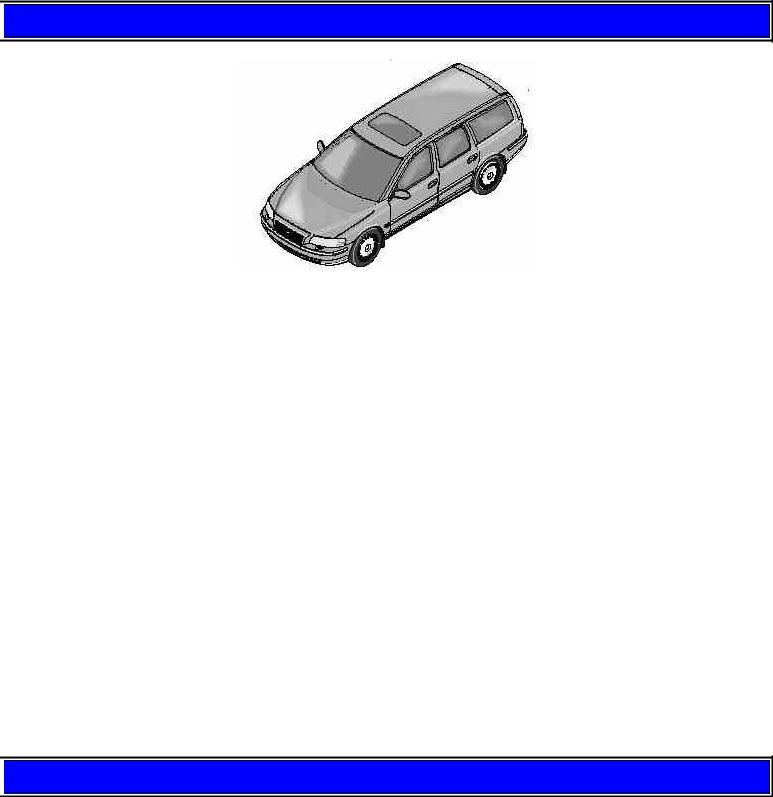
2001 Volvo V70
2 0 0 1 VOLVO V70

 This manual deals with the operation and care of your Volvo.
This manual deals with the operation and care of your Volvo.
Welcome to the worldwide family of Volvo owners. We trust that you will enjoy many years of safe driving in your Volvo, an automobile designed with your safety and comfort in mind. To help ensure your satisfaction with this vehicle, we encourage you to familiarize yourself with the equipment descriptions, operating instructions and maintenance requirements/ recommendations in this manual. We also urge you and your passengers to wear seat belts at all times in this or any other automobile. And, of course, please do not operate a vehicle if you may be affected by alcohol, medication or any impairment that could hinder your ability to drive.
Your Volvo is designed to meet all applicable safety and emission standards, as evidenced by the certification labels attached to the driver's door opening and on the left wheel housing in the engine compartment.
For further information please contact your retailer, or:
In the USA: |
In Canada: |
Volvo Cars of North America |
Volvo Canada Ltd. |
Customer Relations |
175 Gordon Baker Road |
P.O. Box 914 |
Willowdale, Ontario M2H 2N7 |
Rockleigh, New Jersey 07647-0914 |
800-663-8255 |
800-458-1552 |
|
We also invite you to visit our Home Page on the Internet at:
http://www.volvocars.com

 Contents
Contents
http://new.volvocars.com/ownersdocs/2001/2001_V70/01v70_00.htm[4/4/2013 10:37:39 PM]

2001 Volvo V70
Contents
Chapter 1 - Safety
Chapter 2 - Instruments, switches and controls
Chapter 3 - Climate control system
Chapter 4 - Interior
Chapter 5 - Keys, Locks, Alarm
Chapter 6 - Starting and driving
Chapter 7 - Wheels and tires
Chapter 8 - Maintenance/Servicing
Chapter 9 - Specifications
Chapter 10 - Audio systems
HomeLink® Universal Transceiver (option)
Index
Back Cover

 General information
General information
Shiftlock
When your car is parked, the gear selector is locked in the (P)ark position. To release the selector from this position, turn the ignition key to position II (or start the engine), depress the brake pedal, press the button on the front of the gear selector knob and move the selector from (P)ark.
Keylock
This means that when you switch off the ignition, the gear selector must be in the (P)ark position before the key can be removed from the ignition switch.
Anti-lock Brake System (ABS)
The ABS system in your car performs a self-diagnostic test when the vehicle first reaches the speed of approximately 12 mph (20 km/h). The brake pedal will pulsate several times and a sound may be audible from the ABS control module. This is normal.
Fuel filler door
The fuel filler door, located on the right rear fender, is connected to your car's central locking system. The driver's door must be unlocked before the fuel filler door can be opened.
When you lock your car using the central locking button on the driver's door or remote control, the fuel filler door also locks after a 10-minute delay. If you lock your car with the fuel filler door open, you will need to unlock the car to allow the fuel filler door to be closed again.
Fuel filler cap
http://new.volvocars.com/ownersdocs/2001/2001_V70/01v70_00.htm[4/4/2013 10:37:39 PM]

2001 Volvo V70
After refueling, close the fuel filler cap by turning it clockwise until it clicks into place. If this cap is not closed tightly or if the engine is running when the car is refueled, the Malfunction Indicator Lamp ("Check Engine" light) may indicate a fault.

 Volvo and the environment
Volvo and the environment
Volvo is committed to the well being of our customers. As a natural part of this commitment, we care about the environment in which we all live. Caring for the environment means an everyday involvement in reducing our environmental impact.
Volvo's environmental activities are based on a holistic view, which means we consider the overall environmental impact of a product throughout its complete life cycle. In this context, design, production, product use, and recycling are all important considerations.
In production, Volvo has partly or completely phased out several chemicals including freons, lead chromates, naphtanates, asbestos, mercury and cadmium; and reduced the amount of chemicals used in our plants 50% since 1991.
In use, Volvo was the first in the world to introduce into production a three-way catalytic converter with a Lambda sond, now called oxygen sensor, in 1976. The current version of this highly efficient system reduces emissions of harmful substances (CO, HC, NOx) from the exhaust pipe by approximately 95% and the search to eliminate the remaining emissions continues. Volvo is the only automobile manufacturer to offer CFC-free retrofit kits for the air conditioning system for all models as far back as the M/Y 1975 240. Advanced electronic engine controls, refined purification systems and cleaner fuels are bringing us closer to our goal.
After Volvo cars and parts have fulfilled their use, recycling is the next critical step in completing the life cycle. The metal content is about 75% of the total weight of a car, which makes the car among the most recycled industrial products. In order to have efficient and well controlled recycling, many Volvo variants have printed dismantling manuals, indicating the weight and material of individual components. For Volvo, all homogeneous plastic parts weighing more than 1.7 oz. (50 grams) are marked with international symbols that indicate how the component is to be sorted for recycling.
In addition to continuous environmental refinement of conventional gasoline-powered internal combustion engines, Volvo is actively looking at advanced technology alternative-fuel vehicles.
When you drive a Volvo, you become our partner in the work to lessen the car's impact on the environment.
To reduce your vehicle's environmental impact, you can:
·Maintain proper air pressure in your tires. Tests have shown decreased fuel economy with improperly inflated tires
·Follow the recommended maintenance schedule
·Drive at a constant speed
·See an authorized Volvo retailer as soon as possible for inspection if the check engine (malfunction indicator) lamp illuminates, or stays on after the vehicle has started
·Properly dispose of any vehicle related waste such as used motor oil, used batteries, brake pads, etc.
·When cleaning your car, use Volvo's own car care products, all of which have systematically been adapted to the environment
Prem-Air
http://new.volvocars.com/ownersdocs/2001/2001_V70/01v70_00.htm[4/4/2013 10:37:39 PM]

2001 Volvo V70
On the surface of the radiator in the engine compartment, there is a special coating called Prem-Air. Prem-Air works as a catalytic converter, converting most of the ozone passing through the radiator into oxygen, thereby reducing harmful ground-level ozone.
For additional information regarding the environmental activities in
which Volvo Cars of North America, Inc. and Volvo Car Corporation are involved, visit our Internet Home Page at:
http://www.volvocars.com
Top of Page
http://new.volvocars.com/ownersdocs/2001/2001_V70/01v70_00.htm[4/4/2013 10:37:39 PM]
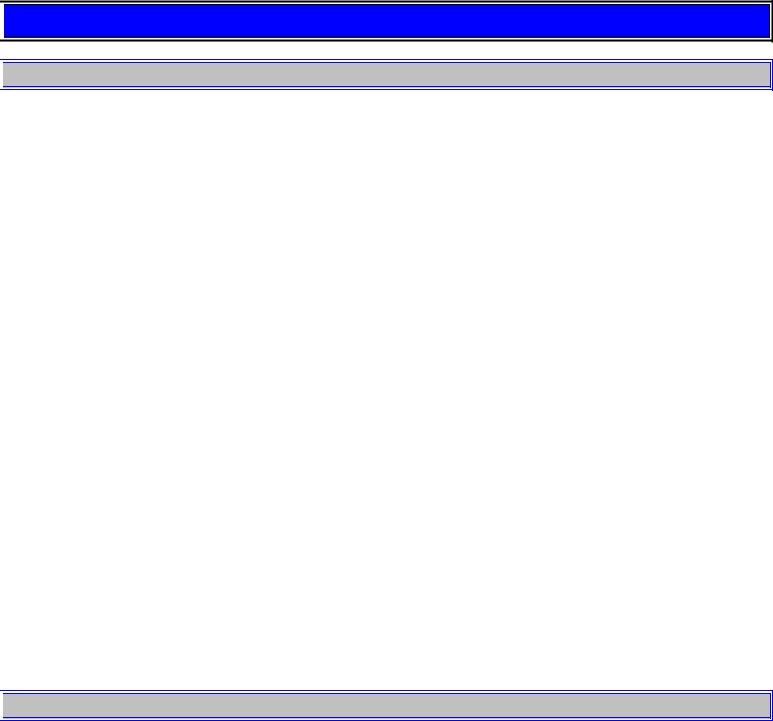
2001 VOLVO V70
2 0 0 1 VOLVO V70

 Chapter 1 - Safety
Chapter 1 - Safety

 pg. 1 Safety
pg. 1 Safety
Not wearing a seat belt is like believing "It'll never happen to me!" Volvo, the inventor of the three-point seat belt, urges you and all adult occupants of your car to wear seat belts and ensure that children are properly restrained, using an infant, car or booster seat determined by age, weight and height. Volvo also believes no child should sit in the front seat of a car. Fact: In every state and province, some type of child-restraint legislation has been passed. Additionally, most states and provinces have already made it mandatory for occupants of a car to use seat belts.
So, urging you to "buckle up" is not just our recommendation - legislation in your state or province may mandate seat belt usage. The few seconds it takes to buckle up may one day allow you to say, "It's a good thing I was wearing my seat belt."
Seat belts 2 Center head restraint 3 Front airbags (SRS) 4 Side impact airbags (SIPS) 8
Volvo Inflatable Curtain (VIC) 9 Whiplash Protection System (WHIPS) 10 Child safety 11 Occupant safety 17 Brake system 18
Anti-lock Brake System (ABS) 19
Stability Traction Control (STC) 20 Dynamic Stability Traction Control (DSTC) 20

 pg. 2 Seat belts
pg. 2 Seat belts
Seat belts
Always fasten the seat belts before you drive or ride. A chime will sound several times if the driver's seat belt is not fastened.
http://new.volvocars.com/ownersdocs/2001/2001_V70/01v70_01a.htm[4/4/2013 10:38:06 PM]
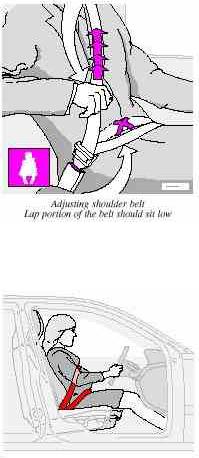
2001 VOLVO V70
To buckle:
Pull the belt out far enough to insert the latch plate into the receptacle until a distinct click is heard. The seat belt retractor is normally "unlocked" and you can move freely, provided that the shoulder belt is not pulled out too far. The retractor will lock up as follows:
 if the belt is pulled out rapidly
if the belt is pulled out rapidly
 during braking and acceleration
during braking and acceleration
 if the vehicle is leaning excessively
if the vehicle is leaning excessively
 when driving in turns For the seat belt to provide maximum protection in the event of an accident, it must be worn correctly. When wearing the seat belt remember:
when driving in turns For the seat belt to provide maximum protection in the event of an accident, it must be worn correctly. When wearing the seat belt remember:
 The belt should not be twisted or turned.
The belt should not be twisted or turned.
 The lap belt must be positioned low on the hips (not pressing against the abdomen).
The lap belt must be positioned low on the hips (not pressing against the abdomen).
Make sure that the shoulder belt is rolled up into its retractor and that the shoulder and lap belts are taut.
Before exiting the car, check that the seat belt retracts fully after being unbuckled. If necessary, guide the belt back into the retractor slot.
NOTE: Legislation in your state or province may mandate seat belt usage.
Child seats: Please refer to page 14 for information on securing child seats with the seat belts.
During pregnancy
Pregnant women should always wear seat belts. Remember that the belt should always be positioned in such a way as to avoid any possible pressure on the abdomen. The lap portion of the belt should be located low, as shown in the above illustration.
http://new.volvocars.com/ownersdocs/2001/2001_V70/01v70_01a.htm[4/4/2013 10:38:06 PM]
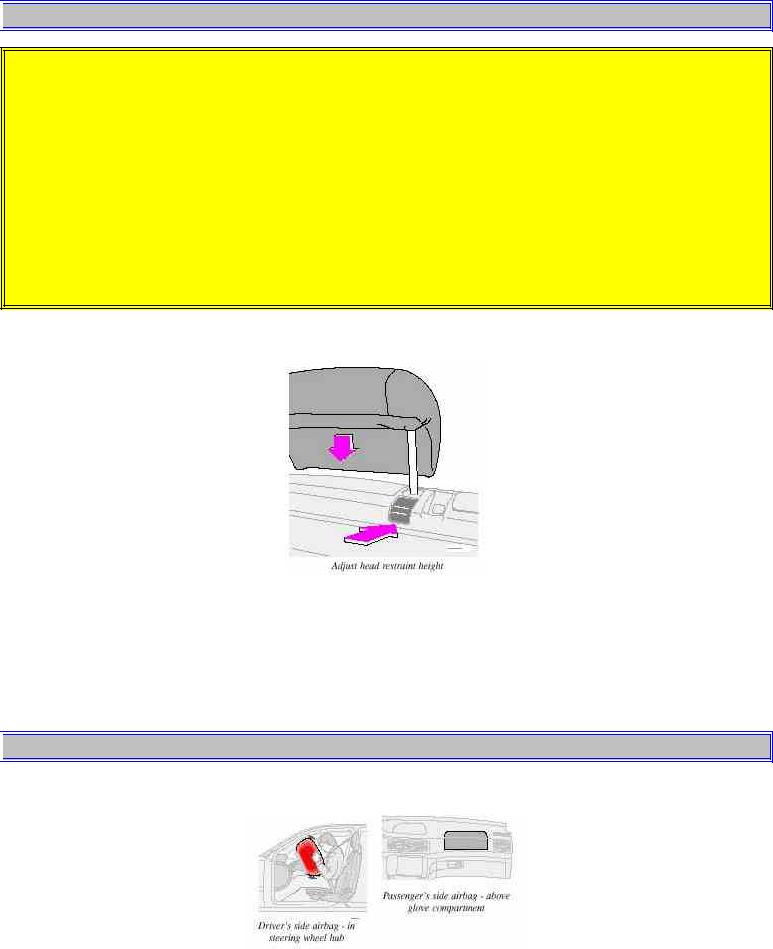
2001 VOLVO V70

 pg. 3 Seat belts, Center head restraint
pg. 3 Seat belts, Center head restraint
WARNING!
 Never use a seat belt for more than one occupant.
Never use a seat belt for more than one occupant.
 Never wear the shoulder portion of the belt under the arm, behind the back or otherwise out of position. Such use could cause injury in the event of an accident.
Never wear the shoulder portion of the belt under the arm, behind the back or otherwise out of position. Such use could cause injury in the event of an accident.
 As the seat belts lose much of their strength when exposed to violent stretching, they should be replaced after any collision, even if they appear to be undamaged.
As the seat belts lose much of their strength when exposed to violent stretching, they should be replaced after any collision, even if they appear to be undamaged.
 Never repair the belt on your own; have this work done by an authorized Volvo retailer only.
Never repair the belt on your own; have this work done by an authorized Volvo retailer only.
 Any device used to induce slack into the shoulder belt portion of the three-point belt system will have a detrimental effect on the amount of protection available to you in the event of a collision.
Any device used to induce slack into the shoulder belt portion of the three-point belt system will have a detrimental effect on the amount of protection available to you in the event of a collision.
 The seat back should not be tilted too far back. The shoulder belt must be taut in order to function properly.
The seat back should not be tilted too far back. The shoulder belt must be taut in order to function properly.
 Do not use child safety seats or child booster cushions/backrests in the front passenger's seat. We also recommend that children who have outgrown these devices sit in the rear seat with the seat belt properly fastened.
Do not use child safety seats or child booster cushions/backrests in the front passenger's seat. We also recommend that children who have outgrown these devices sit in the rear seat with the seat belt properly fastened.
Center head restraint (rear)
The center head restraint can be adjusted according to the passenger's height. The restraint should be carefully adjusted to support the occupant's head.
To raise, lift up to desired position. To lower the center head restraint, press the release button behind the right-hand support while pressing down the head restraint to the desired position.

 pg. 4 Front airbags - SRS
pg. 4 Front airbags - SRS
http://new.volvocars.com/ownersdocs/2001/2001_V70/01v70_01a.htm[4/4/2013 10:38:06 PM]
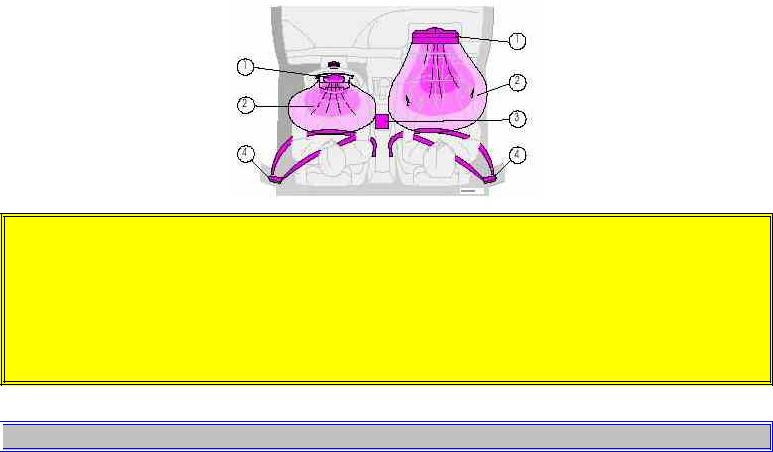
2001 VOLVO V70
As an enhancement to the three-point seat belt system, your Volvo is equipped with a Supplemental Restraint System (SRS). The Volvo SRS consists of an airbag (2) on both the driver's and passenger's sides and seat belt tensioners in both front door pillars (4). The system is designed to supplement the protection provided by the three-point seat belt system. All three rear seat belts are also equipped with tensioners. The SRS system is indicated by the "SRS" embossed on the steering wheel pad and above the glove compartment, and by decals on both sun visors and on the front and far right side of the dash.
The airbags are folded and located in the steering wheel hub and above the glove compartment. They are designed to deploy during certain frontal or front-angular collisions, impacts, or decelerations, depending on the crash severity, angle, speed and object impacted. The airbags may also deploy in certain non-frontal collisions where rapid deceleration occurs.
The airbag system includes gas generators (1) surrounded by the airbags (2) and front seat belt tensioners for both of the front seats (4). To deploy the system, the sensor (3) activates the gas generators causing the airbags to be inflated with nitrogen gas. As the movement of the seats' occupants compresses the airbags, some of the gas is expelled at a controlled rate to provide better cushioning. Both seat belt tensioners also deploy, minimizing any seat belt slack.
The entire process, including inflation and deflation of the airbags, takes approximately two-tenths of a second.
WARNING!
 As its name implies, SRS is designed to be a SUPPLEMENT to -not a replacement for - the three-point belt system. For maximum protection, wear seat belts at all times. Be aware that no system can prevent all possible injuries that may occur in an accident.
As its name implies, SRS is designed to be a SUPPLEMENT to -not a replacement for - the three-point belt system. For maximum protection, wear seat belts at all times. Be aware that no system can prevent all possible injuries that may occur in an accident.
 When installing any optional equipment, make sure that the SRS system is not damaged. Do not attempt to service any component of the SRS yourself. Attempting to do so may result in serious personal injury. If a problem arises, take your car to the nearest authorized Volvo retailer for inspection as soon as possible.
When installing any optional equipment, make sure that the SRS system is not damaged. Do not attempt to service any component of the SRS yourself. Attempting to do so may result in serious personal injury. If a problem arises, take your car to the nearest authorized Volvo retailer for inspection as soon as possible.

 pg. 5 Front airbags - SRS
pg. 5 Front airbags - SRS
http://new.volvocars.com/ownersdocs/2001/2001_V70/01v70_01a.htm[4/4/2013 10:38:06 PM]
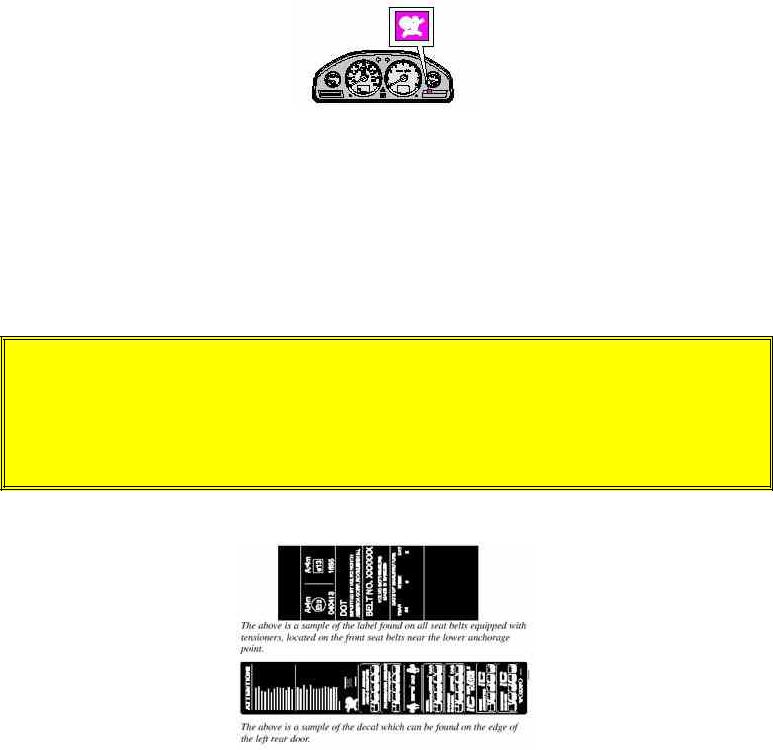
2001 VOLVO V70
A self-diagnostic system incorporated in the sensor monitors the SRS. This system does not, however, monitor the Side Impact Protection System (SIPS) airbags. If a fault is detected, the warning light will illuminate. The light is included in the warning/indicator light cluster in the instrument panel. Normally, the SRS warning lamp should light up when the ignition key is turned to positions I, II or III and should go out after 7 seconds or when the engine is started. Check that this light is functioning properly every time the car is started.
The following items are monitored by the self-diagnostic system:
 Sensor unit
Sensor unit
 Cable harness
Cable harness
 Gas generator igniters
Gas generator igniters
WARNING!
 Never drive an SRS equipped car with your hands on the steering wheel pad / airbag housing.
Never drive an SRS equipped car with your hands on the steering wheel pad / airbag housing.
 No objects, accessory equipment or stickers may be placed on, attached to or installed near the SRS cover in the center of the steering wheel, the SRS cover above the glove compartment or the area affected by airbag deployment.
No objects, accessory equipment or stickers may be placed on, attached to or installed near the SRS cover in the center of the steering wheel, the SRS cover above the glove compartment or the area affected by airbag deployment.  If the SRS warning light stays on after the engine has started or if it comes on while you are driving, drive the car
If the SRS warning light stays on after the engine has started or if it comes on while you are driving, drive the car
to the nearest authorized Volvo retailer for inspection as soon as possible.
There is no maintenance to perform on the SRS yourself. The month and year shown on the decal on the door pillar indicate when you should contact your Volvo retailer for specific servicing or replacement of airbags and seat belt tensioners. This service must be performed by an authorized Volvo retailer.
Should you have any questions about the SRS system, please contact your authorized Volvo retailer or Volvo Customer Support:
In the USA: |
In Canada: |
Volvo Cars of North America |
Volvo Canada Ltd. |
Customer Relations |
175 Gordon Baker Road |
P.O. Box 914 |
Willowdale, Ontario M2H 2N7 |
http://new.volvocars.com/ownersdocs/2001/2001_V70/01v70_01a.htm[4/4/2013 10:38:06 PM]
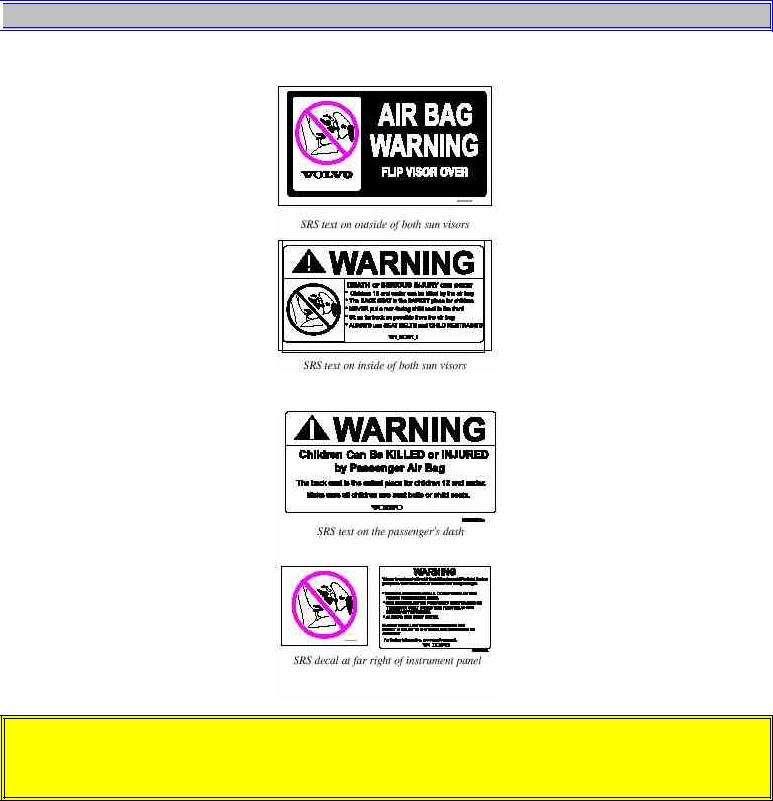
2001 VOLVO V70
Rockleigh, New Jersey 07647-0914 800-663-8255
800-458-1552

 pg. 6 Front airbags - SRS
pg. 6 Front airbags - SRS
WARNING!
Do not use child safety seats or child booster cushions/backrests in the front passenger's seat. We also recommend that occupants under 4 feet 7 inches (140 cm) in height who have outgrown these devices sit in the rear seat with the seat belt fastened.
NOTE: Deployment of SRS components occurs only one time during an accident. In a collision where deployment occurs, the air bags and seat belt tensioners activate. Some noise occurs and a small amount of powder is released. The release of the powder may appear as smoke-like matter. This is a normal characteristic and does not indicate fire.
http://new.volvocars.com/ownersdocs/2001/2001_V70/01v70_01a.htm[4/4/2013 10:38:06 PM]

2001 VOLVO V70
NOTE: Volvo's dual-threshold air bags use special sensors that are integrated with the front seat buckles. The point at which the air bag deploys is determined by whether or not the seat belt is being used, as well as the severity of the collision. Collisions can occur where only one of the airbags deploys.
NOTE: Volvo's dual-stage air bags:If the impact is less severe, but severe enough to present a clear injury risk, the dual-stage airbags are triggered at just 70% of its total capacity. If the impact is more severe, the dual-stage airbags are triggered with full capacity.
WARNING!
 Children must never be allowed in the front passenger seat. Volvo recommends that ALL occupants (adults and children) shorter than 4 feet 7 inches (140 cm) be seated in the back seat of any vehicle with a passenger-side front airbag. See page 14 for guidelines.
Children must never be allowed in the front passenger seat. Volvo recommends that ALL occupants (adults and children) shorter than 4 feet 7 inches (140 cm) be seated in the back seat of any vehicle with a passenger-side front airbag. See page 14 for guidelines.
 Occupants in the front passenger's seat must never sit on the edge of the seat, sit leaning toward the instrument panel or otherwise sit out of position. The occupant's back must be as upright as comfort allows and be against the seat back with the seat belt properly fastened.
Occupants in the front passenger's seat must never sit on the edge of the seat, sit leaning toward the instrument panel or otherwise sit out of position. The occupant's back must be as upright as comfort allows and be against the seat back with the seat belt properly fastened.
 Feet must be on the floor, e.g. not on the dash, seat or out of the window.
Feet must be on the floor, e.g. not on the dash, seat or out of the window.
 No objects or accessory equipment, e.g. dash covers, may be placed on, attached to or installed near the SRS hatch (the area above the glove compartment) or the area affected by airbag deployment (see illustration).
No objects or accessory equipment, e.g. dash covers, may be placed on, attached to or installed near the SRS hatch (the area above the glove compartment) or the area affected by airbag deployment (see illustration).
 There should be no loose articles, e.g. coffee cups, on the floor, seat or dash area.
There should be no loose articles, e.g. coffee cups, on the floor, seat or dash area.
 Never try to open the SRS cover on the steering wheel or the passenger side dash. This should only be done by an authorized Volvo service technician.
Never try to open the SRS cover on the steering wheel or the passenger side dash. This should only be done by an authorized Volvo service technician.
 Failure to follow these instructions can result in injury to the vehicle occupants.
Failure to follow these instructions can result in injury to the vehicle occupants.

 pg. 7 Front airbags - SRS
pg. 7 Front airbags - SRS
NOTE: The information on this page does not pertain to the Side Impact Protection System airbags.
When are the airbags deployed?
The SRS system is designed to deploy during certain frontal or front-angular collisions, impacts, or decelerations, depending on the crash severity, angle, speed and object impacted. The SRS sensor is designed to react to both the impact of the collision and the inertial forces generated by it and to determine if the intensity of the collision is sufficient for the airbags to be deployed.
WARNING!
The SRS is designed to help prevent serious injury. Deployment occurs very quickly and with considerable force. During normal deployment and depending on variables such as seating position, one may experience abrasions, bruises, swellings, or other injuries as a result of airbag(s) deployment.
If the airbags have been deployed, we recommend the following:
 Have the car towed to an authorized Volvo retailer. Never drive with the airbags deployed.
Have the car towed to an authorized Volvo retailer. Never drive with the airbags deployed.
 Have an authorized Volvo retailer replace the SRS system components.
Have an authorized Volvo retailer replace the SRS system components.
 Use only new, Genuine Volvo Parts when replacing SRS components (airbags, seat belts, tensioners, etc.).
Use only new, Genuine Volvo Parts when replacing SRS components (airbags, seat belts, tensioners, etc.).
When are the airbags NOT deployed?
http://new.volvocars.com/ownersdocs/2001/2001_V70/01v70_01a.htm[4/4/2013 10:38:06 PM]

2001 VOLVO V70
Not all frontal collisions activate the SRS system. If the collision involves a nonrigid object (e.g., a snow drift or bush), or a rigid, fixed object at a low speed, the SRS system will not necessarily deploy. Front airbags do not normally deploy in a side impact collision, in a collision from the rear or in a rollover situation. The amount of damage to the bodywork does not reliably indicate if the airbags should have deployed or not.
Seat belts - the heart of the Volvo safety system
The heart of the Volvo safety system is the three-point seat belt (a Volvo invention)! In order for the SRS system to provide the protection intended, seat belts must be worn at all times by everyone in the car. The SRS system is a supplement to the seat belts.
WARNING!
If your car has been subjected to flood conditions (e.g. soaked carpeting/standing water on the floor of the vehicle) or if your car has become flood-damaged in any way, do not attempt to start the vehicle or put the key in the ignition before disconnecting the battery (see below). This may cause airbag deployment which could result in personal injury. Have the car towed to an authorized Volvo retailer for repairs.
Automatic transmission:
Before attempting to tow the car, use the following procedure to override the shiftlock system to move the gear selector to the neutral position.
 Switch off the ignition for at least 10 minutes and disconnect the battery
Switch off the ignition for at least 10 minutes and disconnect the battery
 Wait at least one minute
Wait at least one minute
 Insert the key in the ignition and turn it to position II
Insert the key in the ignition and turn it to position II
 Press firmly on the brake pedal.
Press firmly on the brake pedal.
 Move the gear selector from (P)ark to the (N)eutral position.
Move the gear selector from (P)ark to the (N)eutral position.
WARNING!
Never drive with the airbags deployed. The fact that they hang out can impair the steering of your car. Other safety systems can also be damaged. The smoke and dust formed when the airbags are deployed can cause skin and eye irritation in the event of prolonged exposure.

 pg. 8 Side impact airbags (SIPS)
pg. 8 Side impact airbags (SIPS)
SIPS airbag (front seats only)
As an enhancement to the structural Side Impact Protection System built into your car, the car is also equipped with Side Impact Protection System (SIPS) airbags. The SIPS airbag system consists of airbag modules built into the sides of both front seat backrests (1), wires (2) and gas generators/sensor units (3). The SIPS airbag system is designed to help increase occupant protection in the event of certain side impact collisions. The SIPS airbags are designed to deploy only during certain side-impact collisions, depending on the crash severity, angle, speed and point of impact. The airbags are not designed to deploy in all side impact situations.
WARNING!
 The SIPS airbag system is a supplement to the Side Impact Protection System and the three-point seat belt system. It is not designed to deploy during collisions from the front or rear of the car or in rollover situations.
The SIPS airbag system is a supplement to the Side Impact Protection System and the three-point seat belt system. It is not designed to deploy during collisions from the front or rear of the car or in rollover situations.
 The use of seat covers on the front seats may impede SIPS airbag deployment.
The use of seat covers on the front seats may impede SIPS airbag deployment.
http://new.volvocars.com/ownersdocs/2001/2001_V70/01v70_01a.htm[4/4/2013 10:38:06 PM]
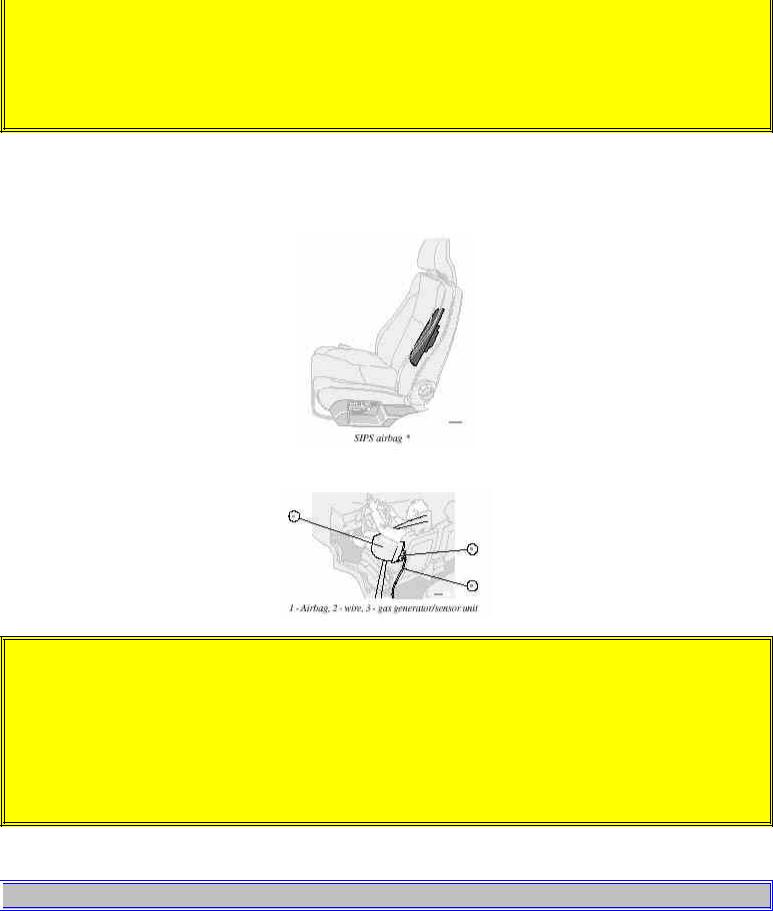
2001 VOLVO V70
 No objects, accessory equipment or stickers may be placed on, attached to or installed near, the SIPS airbag system or in the area affected by SIPS airbag deployment (see illustration to the right above).
No objects, accessory equipment or stickers may be placed on, attached to or installed near, the SIPS airbag system or in the area affected by SIPS airbag deployment (see illustration to the right above).
 Never try to open or repair any components of the SIPS airbag system. This should be done only by an authorized Volvo service technician.
Never try to open or repair any components of the SIPS airbag system. This should be done only by an authorized Volvo service technician.
 In order for the SIPS airbag to provide its best protection, both front seat occupants should sit in an upright position with the seat belt properly fastened.
In order for the SIPS airbag to provide its best protection, both front seat occupants should sit in an upright position with the seat belt properly fastened.
*A SIPS airbag warning decal is also located at the end of the instrument panel on the driver's side of the car.
NOTE: SIPS airbag deployment (one airbag) occurs only on the side of the vehicle affected by the impact.
WARNING!
 Never drive with the airbags deployed. The fact that they hang out can impair the steering of your car. Other safety systems can also be damaged. The smoke and dust formed when the airbags are deployed can cause skin and eye irritation in the event of prolonged exposure.
Never drive with the airbags deployed. The fact that they hang out can impair the steering of your car. Other safety systems can also be damaged. The smoke and dust formed when the airbags are deployed can cause skin and eye irritation in the event of prolonged exposure.
 If your car has been subjected to flood conditions (e.g. soaked carpeting/ standing water on the floor of the vehicle) or if your car has become flood-damaged in any way, do not attempt to start the vehicle or put the key in the ignition before disconnecting the battery. This may cause airbag deployment which could result in personal injury. Have the car towed to an authorized Volvo retailer for repairs.
If your car has been subjected to flood conditions (e.g. soaked carpeting/ standing water on the floor of the vehicle) or if your car has become flood-damaged in any way, do not attempt to start the vehicle or put the key in the ignition before disconnecting the battery. This may cause airbag deployment which could result in personal injury. Have the car towed to an authorized Volvo retailer for repairs.

 pg. 9 Volvo Inflatable Curtain (VIC)
pg. 9 Volvo Inflatable Curtain (VIC)
http://new.volvocars.com/ownersdocs/2001/2001_V70/01v70_01a.htm[4/4/2013 10:38:06 PM]
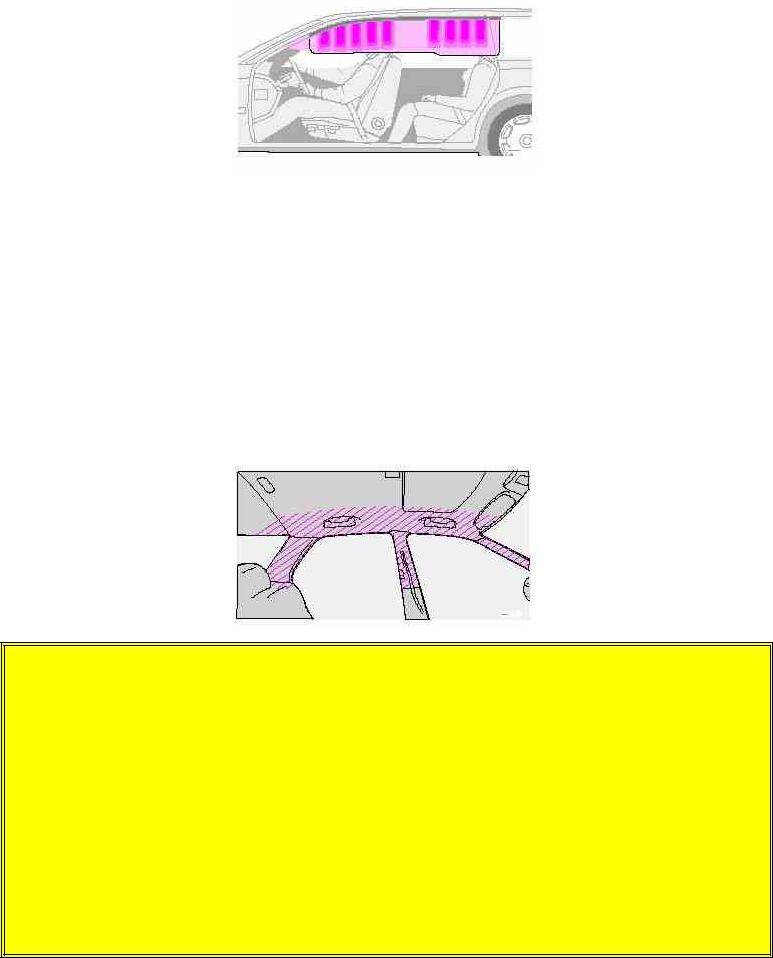
2001 VOLVO V70
Volvo Inflatable Curtain (VIC)
This system consists of inflatable curtains located along the sides of the roof liners, stretching from the center of both front side windows to the rear edge of the rear side door windows. It is designed to help protect the heads of the occupant of the front seat and the occupant of the outboard rear seat position in certain side impact collisions.
NOTE: IC system deployment occurs only on the side of the vehicle affected by the impact.
In certain side impacts, BOTH the Inflatable Curtain (IC) and the Side Impact Airbag System (SIPS-bag) will deploy, whereas, in some cases, ONLY the Inflatable Curtain (IC) will deploy. In cases where BOTH the IC and the SIPS-bag deploy, deployment will occur simultaneously.
If the inflatable curtain deploys, it remains inflated for approximately 3 seconds.
WARNING!
 The IC system is a supplement to the Side Impact Protection System. It is not designed to deploy during collisions from the front or rear of the car or in most rollover situations.
The IC system is a supplement to the Side Impact Protection System. It is not designed to deploy during collisions from the front or rear of the car or in most rollover situations.
 Never try to open or repair any components of the IC system. This should be done only by an authorized Volvo service technician.
Never try to open or repair any components of the IC system. This should be done only by an authorized Volvo service technician.
 The inflatable curtains are designed to deploy only during certain side-impact collisions, depending on the crash severity, angle, speed and impact. The inflatable curtains are not designed to deploy in all side impact situations.
The inflatable curtains are designed to deploy only during certain side-impact collisions, depending on the crash severity, angle, speed and impact. The inflatable curtains are not designed to deploy in all side impact situations.  In order for the IC to provide its best protection, both front seat occupants and both outboard rear seat occupants
In order for the IC to provide its best protection, both front seat occupants and both outboard rear seat occupants
should sit in an upright position with the seat belt properly fastened; adults using the seat belt and children using the proper child restraint system. Only adults should sit in the front seats. Children must never be allowed in the front passenger seat. See page 14 for guidelines. Failure to follow these instructions can result in injury to the vehicle occupants.
 When the rear seat backrest(s) are folded down, the car should not be loaded to a level higher than 2 in. (5 cm) below the upper edge of the rear passenger door windows. Objects placed higher than this level could impede the function of the inflatable curtain.
When the rear seat backrest(s) are folded down, the car should not be loaded to a level higher than 2 in. (5 cm) below the upper edge of the rear passenger door windows. Objects placed higher than this level could impede the function of the inflatable curtain.
http://new.volvocars.com/ownersdocs/2001/2001_V70/01v70_01a.htm[4/4/2013 10:38:06 PM]
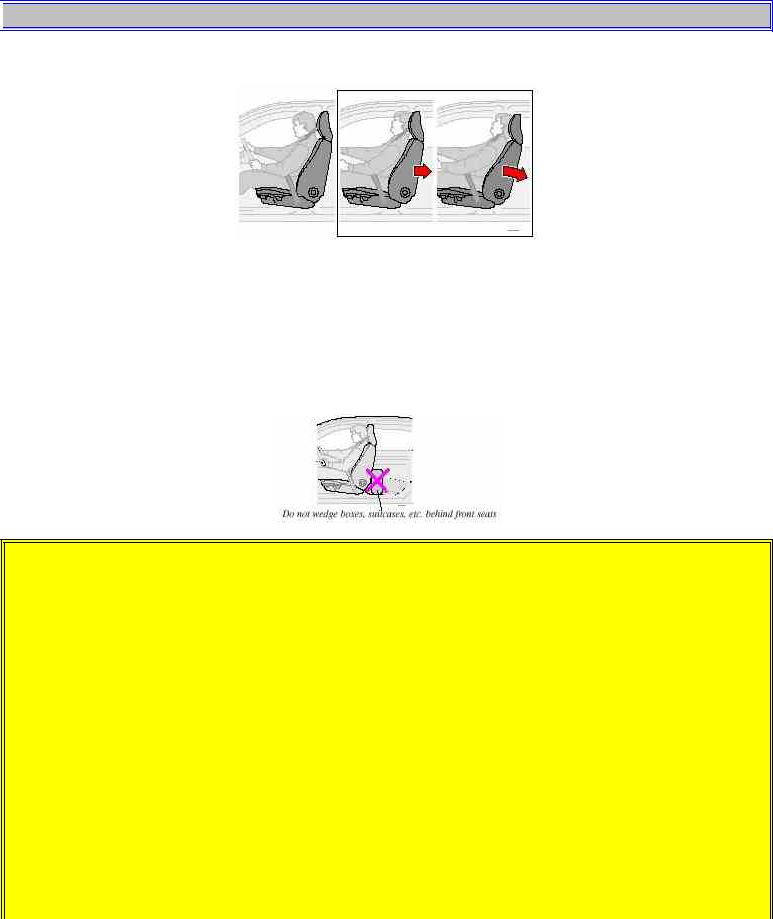
2001 VOLVO V70

 pg. 10 Whiplash Protection System (WHIPS)
pg. 10 Whiplash Protection System (WHIPS)
Whiplash Protection System (WHIPS) - front seats only
The WHIPS system consists of specially designed hinges and brackets on the front seat backrests and head restraints designed to help absorb some of the energy generated in a collision from the rear ("rear-ended"). In the event of a collision of this type, the hinges and brackets of the front seat backrests are designed to change position slightly to allow the backrest/head restraint to help support the occupant's head before moving slightly rearward. This movement helps absorb some of the forces that could result in the whiplash effect.
WARNING!
 Any contact between the front seat backrests and the folded rear seat could impede the function of the WHIPS system. If the rear seat is folded down, the occupied front seats must be adjusted forward so that they do not touch the folded rear seat.
Any contact between the front seat backrests and the folded rear seat could impede the function of the WHIPS system. If the rear seat is folded down, the occupied front seats must be adjusted forward so that they do not touch the folded rear seat.
 Boxes, suitcases, etc. wedged behind the front seats (see illustration above) could impede the function of the WHIPS system.
Boxes, suitcases, etc. wedged behind the front seats (see illustration above) could impede the function of the WHIPS system.
 The WHIPS system is designed to supplement the other safety systems in your car. For this system to function properly, the three-point seat belt must be worn. Please be aware that no system can prevent all possible injuries that may occur in an accident.
The WHIPS system is designed to supplement the other safety systems in your car. For this system to function properly, the three-point seat belt must be worn. Please be aware that no system can prevent all possible injuries that may occur in an accident.
 If your car has been involved in a collision, the front seat backrests must be inspected by an authorized Volvo retailer even if the seats appear to be undamaged. Certain components in the WHIPS system may need to be replaced. Do not attempt to service any component in the WHIPS system yourself.
If your car has been involved in a collision, the front seat backrests must be inspected by an authorized Volvo retailer even if the seats appear to be undamaged. Certain components in the WHIPS system may need to be replaced. Do not attempt to service any component in the WHIPS system yourself.
 If the rear seat backrests are folded down, cargo must be secured to prevent it from sliding forward against the front seat backrests in the event of a collision from the rear. This could interfere with the action of the WHIPS system.
If the rear seat backrests are folded down, cargo must be secured to prevent it from sliding forward against the front seat backrests in the event of a collision from the rear. This could interfere with the action of the WHIPS system.
 The WHIPS system is designed to function in certain collisions from the rear, depending on the crash severity, angle and speed.
The WHIPS system is designed to function in certain collisions from the rear, depending on the crash severity, angle and speed.
 Occupants in the front seats must never sit out of position. The occupant's back must be as upright as comfort allows and be against the seat back with the seat belt properly fastened.
Occupants in the front seats must never sit out of position. The occupant's back must be as upright as comfort allows and be against the seat back with the seat belt properly fastened.
http://new.volvocars.com/ownersdocs/2001/2001_V70/01v70_01a.htm[4/4/2013 10:38:06 PM]

2001 VOLVO V70
Contents | Top of Page
http://new.volvocars.com/ownersdocs/2001/2001_V70/01v70_01a.htm[4/4/2013 10:38:06 PM]

2001 VOLVO V70
2 0 0 1 |
|
|
|
|
VOLVO |
|
|
|
V70 |
|
|
|
|
|
|
|
Chapter 2 - Instruments, switches and controls |
|
|
|
|
|
|
|
|
|
|
|
pg. 21 Instruments, switches and controls |
|
|
|
|
|
|
|
Interior |
22 |
|
|
Exterior |
23 |
|
|
Instruments |
24 |
|
|
Instrument panel |
25 |
|
|
Indicator and warning lights |
26 |
|
|
Text information window |
28 |
|
|
Switches in the center console |
29 |
|
|
Trip computer |
30 |
|
|
Cruise control |
31 |
|
|
Headlights, parking lights, fog lights, instrument illumination |
32 |
|
|
Steering wheel adjustment, Ignition switch/Steering wheel lock |
33 |
|
|
Turn signals |
34 |
|
|
Windshield wipers/washers |
35 |
|
|
Warning flashers, heated mirrors/rear window, heated front seats |
36 |
|
|
Parking brake, auxiliary socket/ashtrays |
37 |
|
|
Electrically operated windows |
38 |
|
|
Rearview/sideview mirrors |
39 |
|
|
Sun roof |
40 |
|

 pg. 22 Instruments, switches and controls
pg. 22 Instruments, switches and controls
http://new.volvocars.com/ownersdocs/2001/2001_V70/01v70_02a.htm[4/4/2013 10:38:21 PM]
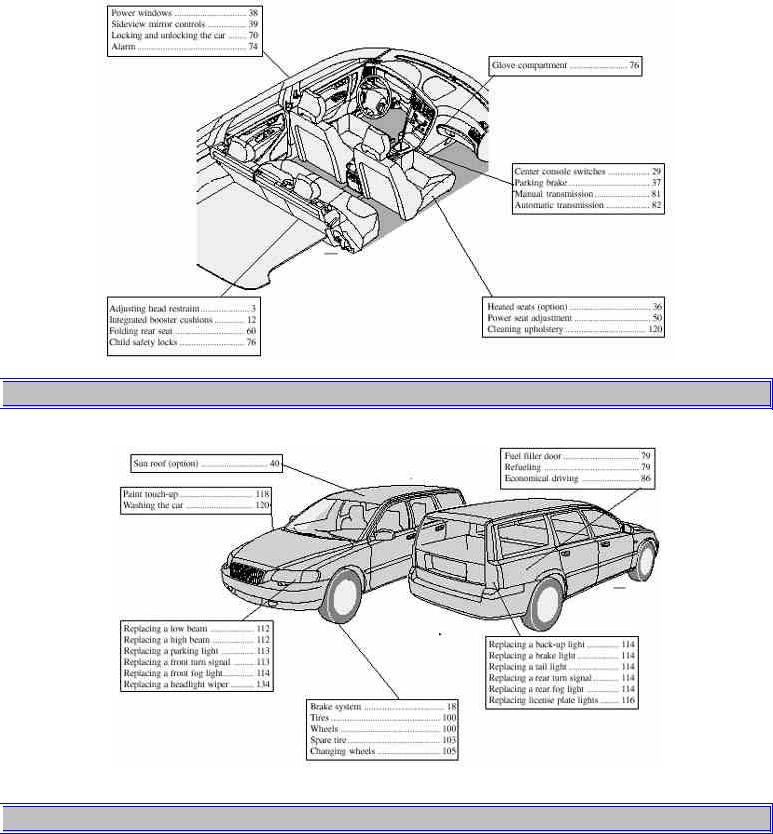
2001 VOLVO V70

 pg. 23 Instruments, switches and controls
pg. 23 Instruments, switches and controls

 pg. 24 Instruments, switches and controls
pg. 24 Instruments, switches and controls
http://new.volvocars.com/ownersdocs/2001/2001_V70/01v70_02a.htm[4/4/2013 10:38:21 PM]
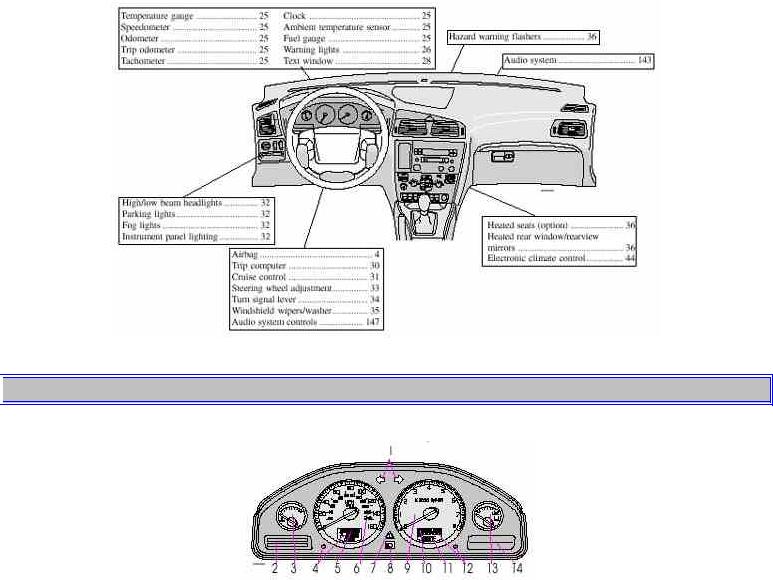
2001 VOLVO V70

 pg. 25 Instruments, switches and controls
pg. 25 Instruments, switches and controls
1 Turn signals
2 Text window
3 Temperature gauge
The pointer should be approximately midway on the gauge when driving.
Do not drive the car if the warning light is on. The text window will provide you with additional information.
If the engine temperature remains high, check coolant level - see page 125.
4 Trip odometer/reset button
The trip odometer is used for measuring shorter distances. The last digit indicates 1/10 mile/kilometer. Press the button quickly to toggle between trip odometers 1 and 2. Hold in the button for more than 2 seconds to reset.
5Odometer
6Speedometer
7General warning light (see see page 26).
http://new.volvocars.com/ownersdocs/2001/2001_V70/01v70_02a.htm[4/4/2013 10:38:21 PM]
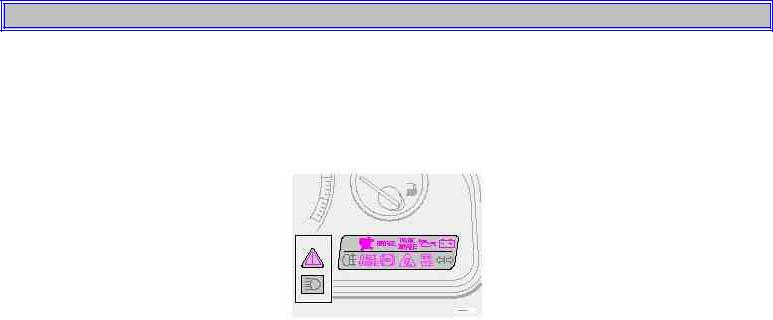
2001 VOLVO V70
8 High beam indicator light
9 Tachometer
Indicates engine speed in thousands of rpm. Do not drive for long with the needle in the red section. The engine has an built-in function preventing too high an engine speed. When this function operates, you may discern some pulsation, which in that case is quite normal.
10 Gear and driving mode indicator
The currently selected driving mode is displayed here. If you use the geartronic function on the automatic transmission, the currently selected gear will be displayed.
11 Ambient temperature indicator
This display indicates the air temperature outside your car. A "snowflake" symbol in the text window is displayed when the temperature is in the range of 23 - 36¡ F (-5 - +2¡ C).
Please note that this symbol does not indicate a fault with your car.
At low speeds or when the car is not moving, the temperature readings may be slightly higher than the actual ambient temperature.
12 Clock/reset button
Turn the button to adjust the clock.
13 Fuel gauge
The fuel tank holds approximately 21.1 US gal. (80 liters)*. When the warning light comes on there are approximately 1.8 US gal. (8 liters) of fuel remaining.
14 Indicator and warning lights
* 18.5 US gals (70 liters) on V70 AWD, V70 XC and V70 with non-turbo engine.
pg. 26 Instruments, switches and controls
The indicator and warning lights described on pages 26 and 27 should never stay on when driving*
When the ignition key is turned, all of the warning lights in the lower right-hand side of the instrument panel should go on to test the function of the bulbs. If a light does not go off after the engine has started, the system indicated should be inspected.
NOTE: The parking brake reminder light will not go off until the parking brake has been fully released.
http://new.volvocars.com/ownersdocs/2001/2001_V70/01v70_02a.htm[4/4/2013 10:38:21 PM]

2001 VOLVO V70
Warning lamp  in the center of the instrument panel
in the center of the instrument panel
This lamp lights up red or orange depending on the severity of the fault that has been detected.
Orange light: Follow the instructions shown in the text window.
Red light: Stop the car as soon as possible in a suitable location and read the message shown in the text window.
Supplemental Restraint System (SRS)
If the light comes on (or stays on after the vehicle has started), the SRS diagnostic system has detected a fault. Drive to an authorized Volvo retailer for an inspection of the system. See the SRS section for more information.
Brake failure warning light
If the light comes on while driving or braking, stop immediately, open the hood and check the brake fluid level in the reservoir. See page 128 for reservoir position and page 131 for instructions.
Canadian models are equipped with this warning light: 
Parking brake reminder light
This light will be on when the parking brake (hand brake) is applied. The parking brake lever is situated between the front seats. Canadian models are equipped with this warning light: 
Oil pressure warning light
If the light comes on while driving, stop the car and then stop the engine immediately and check the engine oil level. See page 130. If the light stays on after restart, have the car towed to the nearest authorized Volvo retailer. After hard driving, the light may come on occasionally when the engine is idling. This is normal, provided it goes off when the engine speed is increased.
Generator warning light
If the light comes on while the engine is running, have the charging system checked.
http://new.volvocars.com/ownersdocs/2001/2001_V70/01v70_02a.htm[4/4/2013 10:38:21 PM]
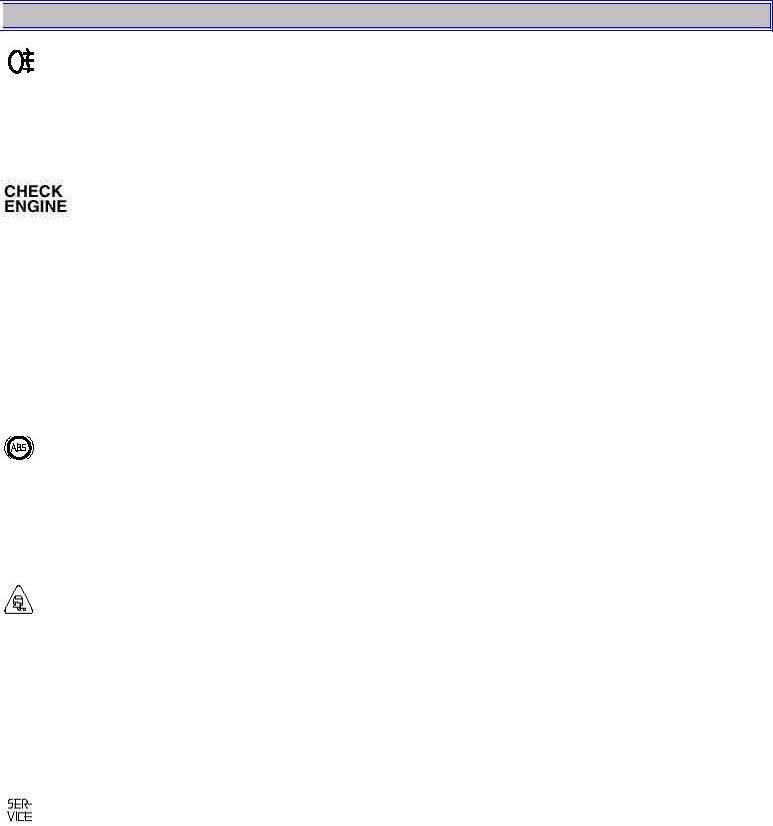
2001 VOLVO V70
* Rear fog light, if used, and trailer turn signal, if towing a trailer, will go on while driving.

 pg. 27 Instruments, switches and controls
pg. 27 Instruments, switches and controls
Rear fog light
This light indicates that the rear fog light is on.
Malfunction indicator lamp
If the light comes on (or stays on after the vehicle has started), the engine diagnostic system has detected a possible fault in the emission control system. Although driveability may not be affected, see an authorized Volvo retailer as soon as possible for inspection. Canadian models are equipped with this warning light:
NOTE: If the fuel filler cap is not closed tightly or if the engine is running when the is refueled, the Malfunction Indicator Lamp may indicate a fault. However, your vehicle's performance will not be affected. Use only Volvo original or approved fuel filler caps. 
Anti-lock Brake System ABS
If the warning light comes on, there is a malfunction of the ABS system (the standard braking system will still function). The vehicle should be driven to a Volvo retailer for inspection. See page 19 for additional information.
Stability Traction Control (STC) system (option)
Dynamic Stability and Traction Control (DSTC) system (option)
An LED in the STC or DSTC switch in the center console will light up to indicate that the system is activated. See page 20 for further information.
Service reminder indicator
This light will come on at 7,500 mile (12,000 km) intervals, after 750 hours of driving or after 12 months, whichever occurs first, to remind the driver that the service interval has been exceeded. The light will stay on for 2 minutes after
http://new.volvocars.com/ownersdocs/2001/2001_V70/01v70_02a.htm[4/4/2013 10:38:21 PM]

2001 VOLVO V70
start until reset by the servicing retailer.
Turn signal indicator - trailer (certain models)
If you are towing a trailer, this light will flash simultaneously with the turn signals on the trailer. If the light does not flash when signaling, neither the trailer's turn signals nor the car's turn signals are functioning.

 pg. 28 Instruments, switches and controls
pg. 28 Instruments, switches and controls
Messages in the text window
When a warning light in the instrument panel comes on, a message is also displayed in the text window. After you have read the message, you can erase it by pressing button A (see illustration above).
NOTE: Certain messages cannot be erased until the condition has been corrected.
If a warning message is displayed when e.g. you are using the trip computer or would like to use the telephone, this message must be erased before you can access the function of your choice. Press button A to erase the warning message.
Erased messages are stored in the system's memory until the required action has been taken. You can scroll through the stored messages by pressing button A. The text window can be cleared (the message will be returned to memory) by pressing button A again.
General messages
SLOW DOWN: Reduce speed to help prevent damage.
DRIVE SLOWLY: Drive the car carefully to an authorized Volvo retailer for inspection.
STOP SAFELY ASAP: Stop and switch off the engine - to help prevent serious risk of damage.
SERVICE URGENT: Take your car to an authorized Volvo retailer for inspection as soon as possible.
SERVICE REQUIRED: Take your car to an authorized Volvo retailer for inspection at your convenience (but preferably before the next scheduled maintenance service).
FIX NEXT SERVICE: Have the system affected inspected at the next scheduled maintenance service.
http://new.volvocars.com/ownersdocs/2001/2001_V70/01v70_02a.htm[4/4/2013 10:38:21 PM]
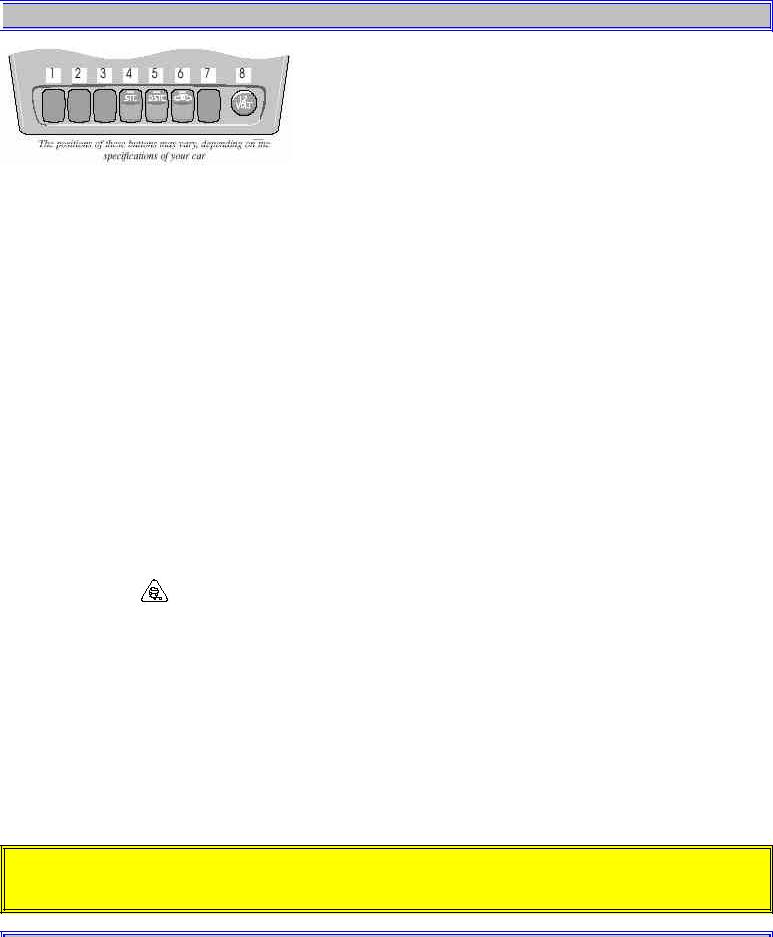
2001 VOLVO V70
SEE MANUAL: Refer to your owner's manual. For additional information, please contact your Volvo retailer.

 pg. 29 Instruments, switches and controls
pg. 29 Instruments, switches and controls
1.Not in use
2.Not in use
3.Not in use
4.Stability Traction Control (STC) -option
Press this switch for at least half a second to turn the STC system on or off. An LED in the switch will light up to indicate that the system is on. See page 20 for more information on STC. This system should be switched off if you, for any reason, temporarily have to drive with tires of different dimensions (e.g., spare tire).
NOTE: To help reduce the risk that this system is turned off inadvertently, the switch must be held in for at least half a second to turn STC off. The warning symbol in the instrument panel will light up to indicate that STC is OFF.
5. Dynamic Stability Traction Control (DSTC) - option
This button is used to switch DSTC off. When the LED in the button is ON, this indicates that the system is ON (the light will also come on if a fault has been detected in the system).
NOTE: To avoid inadvertently switching the system off, the button must be pressed for at least half a second before DSTC is deactivated.
The warning symbol |
will come on to indicate that DSTC has been switched off. The system is automatically |
switched on when the engine is started. DSTC should be switched off if the steering wheel position or the front wheels are not properly aligned.
6.This button is used to temporarily disconnect alarm sensors. See page 75 for further information.
7.Not in use
8.Auxiliary socket
This 12 volt socket can be used to plug in certain accessories such as cellular telephones, etc. The ignition key must be in position 1 (or higher) for the auxiliary socket to function.
NOTE: The auxiliary sockets can also be used for cigarette lighters, which are available at your Volvo retailer.
WARNING!
Please be aware that the car's handling characteristics may be affected if Dynamic Stability Traction Control (DSTC) is switched off.
http://new.volvocars.com/ownersdocs/2001/2001_V70/01v70_02a.htm[4/4/2013 10:38:21 PM]
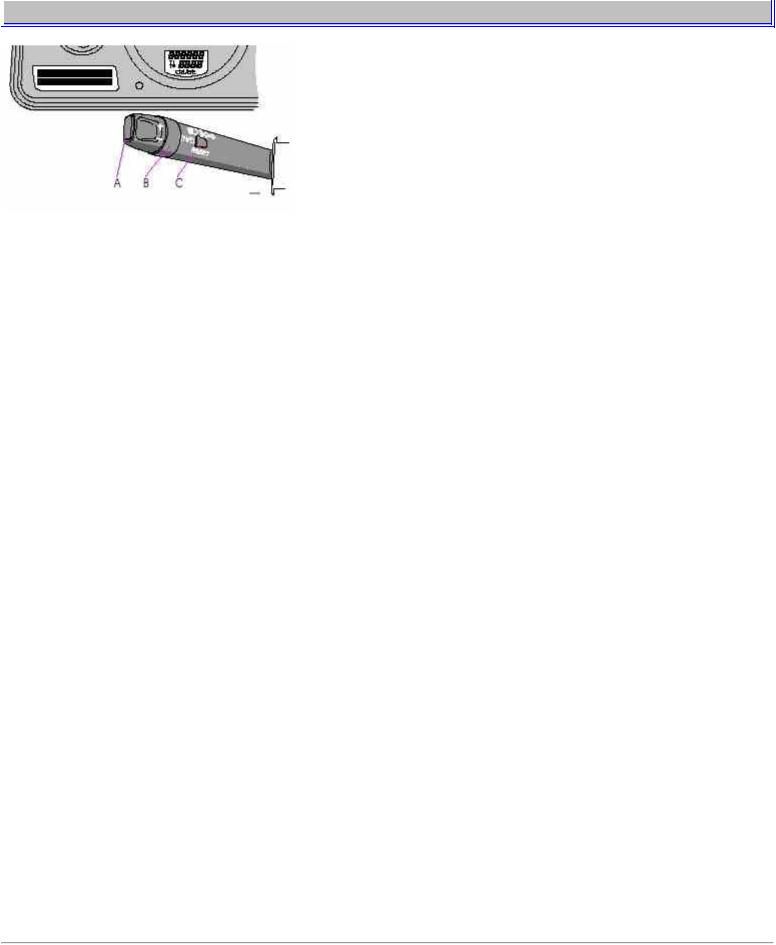
2001 VOLVO V70

 pg. 30 Instruments, switches and controls
pg. 30 Instruments, switches and controls
Trip computer
The trip computer stores information gathered from several systems in your car and has four menus that can be displayed in the text window.
 Driving distance on current fuel reserve
Driving distance on current fuel reserve
 Average fuel consumption
Average fuel consumption
 Current fuel consumption
Current fuel consumption  Average speed
Average speed
NOTE: Warning messages from the car's monitoring systems will override the trip computer function. If a warning message is displayed in the text window while you are using the trip computer, you must acknowledge the message by pressing button A. Press button A again to return to the trip computer function.
Trip computer controls
The four trip computer functions can be accessed by twisting control B one step at a time in either direction. Twisting a fifth time returns you to the original function. The trip computer can be reset (current data will be erased from system memory) by pressing RESET (button C).
Trip computer functions
Driving distance on current fuel reserve This function shows the approximate distance that can be driven on the fuel remaining in the tank. This calculation is based on average fuel consumption during the last 12 miles (20 km) of driving and the amount of fuel remaining in the tank when the reading was taken. When the driving distance on current fuel reserve is less than 12 miles (20 km), "----" will be displayed in the text window.
Average fuel consumption This value indicates fuel consumption since the last time the trip computer was reset (by pressing RESET, button C). When the engine is switched off, information on fuel consumption is stored and remains in system memory until the RESET (button C) is pressed again.
Current fuel consumption This value indicates the current fuel consumption, based on readings taken once per second. When the car is not moving, "----" will be displayed.
Average speed This value indicates average speed since the last time the trip computer was reset (by pressing RESET, button C). When the engine is switched off, information on average speed is stored and remains in system memory until the RESET (button C) is pressed again.
http://new.volvocars.com/ownersdocs/2001/2001_V70/01v70_02a.htm[4/4/2013 10:38:21 PM]

2001 VOLVO V70
Contents | Top of Page
http://new.volvocars.com/ownersdocs/2001/2001_V70/01v70_02a.htm[4/4/2013 10:38:21 PM]

2001 VOLVO V70
2 0 0 1 VOLVO V70

 Chapter 3 - Climate control system
Chapter 3 - Climate control system

 pg. 41 Climate control system
pg. 41 Climate control system
Ventilation 42
Climate control system - general information 43
Electronic Climate Control (ECC) 44

 pg. 42 Ventilation
pg. 42 Ventilation
Air vents (dash)
AOpen
BClosed
CHorizontal air flow
DVertical air flow
Direct the outer air vents toward the side windows to demist.
In cold weather, close the air vents in the center of the dash to direct as much air as possible toward the windows.
http://new.volvocars.com/ownersdocs/2001/2001_V70/01v70_03.htm[4/4/2013 10:38:34 PM]
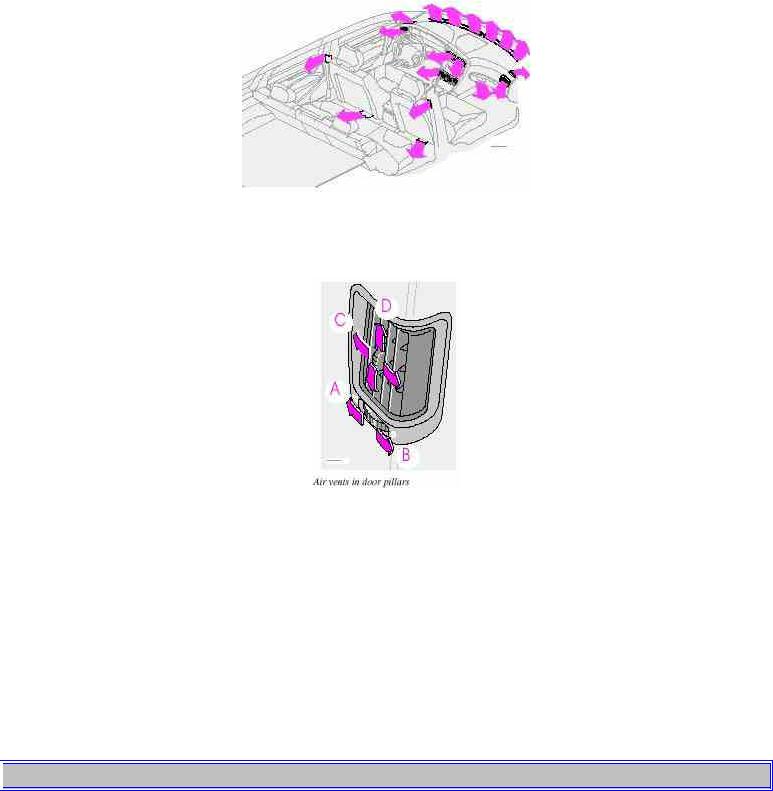
2001 VOLVO V70
Air flow
The air that is drawn into the passenger compartment is distributed from 14 ventilation points.
Air vents in door pillars
AOpen
BClosed
CHorizontal air flow
DVertical air flow
Direct the air vents toward the rear side windows to demist.
Direct the air vents toward the rear seat for the best heating/cooling effect.

 pg. 43 Climate control system - general information
pg. 43 Climate control system - general information
Condensation on the inside of the windows
Keeping the insides of the windows clean will help reduce the amount of condensation that forms on the windows. Use a commercial window cleaning agent to clean the windows.
Ice and snow
http://new.volvocars.com/ownersdocs/2001/2001_V70/01v70_03.htm[4/4/2013 10:38:34 PM]

2001 VOLVO V70
Always keep the air intake grille at the base of the windshield free of snow.
Cabin air filter
Replace the cabin air filter with a new one at the recommended intervals. The filter should be replaced more often when driving under dirty and dusty conditions. The filter cannot be cleaned and therefore should always be replaced with a new one.
Sensors
The sunlight sensor on the dashboard and passenger compartment temperature sensor in the ECC control panel should not be covered in any way as this could cause incorrect information to be sent to the ECC system.
Parking the car in warm weather
If your car has been parked in the sun in warm weather, opening the windows and sun roof (option) for several minutes before driving will help release the warm air from the passenger compartment. When the engine is running, close the windows and sun roof and use the recirculation function for several minutes to enable the air conditioning to cool the compartment as quickly as possible.
Windows and optional sun roof
The ECC system will function best if the windows and optional sun roof are closed. If you drive with the sun roof open, we recommend that you manually adjust the temperature and blower control (the LED in the AUTO switch should be off).
Acceleration
The air conditioning is momentarily disengaged during full-throttle acceleration.
ECC maintenance
All maintenance on the climate control systems should be carried out by an authorized Volvo service technician only.
Refrigerant
Volvo cares about the environment. The air conditioning system in your car contains a CFC-free refrigerant - R134a. This substance will not deplete the ozone layer. The system contains 2.2 lbs (1000 g) R134a and uses PAG oil.
Passenger compartment blower
Approximately 50 minutes after the ignition is turned off, the blower may come on automatically, and run for five minutes, to remove condensation in the A/C evaporator.

 pg. 44 Electronic Climate Control (ECC)
pg. 44 Electronic Climate Control (ECC)
http://new.volvocars.com/ownersdocs/2001/2001_V70/01v70_03.htm[4/4/2013 10:38:34 PM]
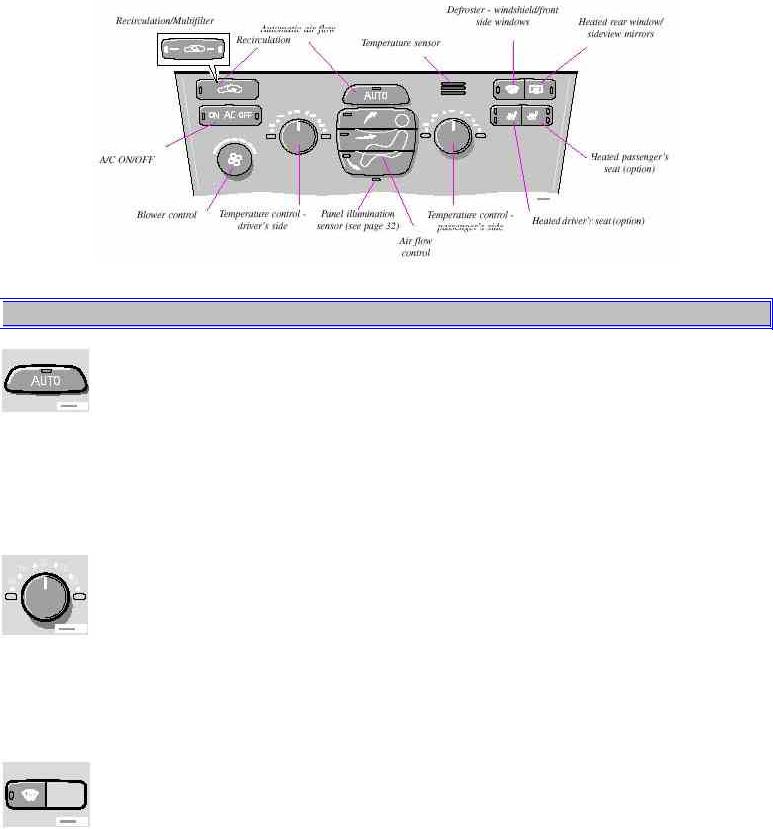
2001 VOLVO V70

 pg. 45 Electronic Climate Control (ECC)
pg. 45 Electronic Climate Control (ECC)
AUTO
This function automatically regulates the Electronic Climate Control system so that the selected temperatures are maintained. The blower, heating, air distribution (air flow) and air conditioning are controlled. If you prefer to manually set any of these functions, the remaining functions will still be controlled automatically. Pressing the AUTO button overrides any settings that were previously made manually.
Temperature
These controls are used to individually set the temperature for both sides of the passenger compartment. Please note that the compartment will not be heated or cooled faster by setting the temperature higher or lower than necessary. Set the control to the temperature you prefer.
Defroster
This function demists/de-ices the windshield and front side windows. The LED in the switch will light up to indicate that the defrost function is engaged. Blower speed increases automatically and the air in the passenger compartment is dehumidified. Recirculation will not function while defrost is engaged.
http://new.volvocars.com/ownersdocs/2001/2001_V70/01v70_03.htm[4/4/2013 10:38:34 PM]
